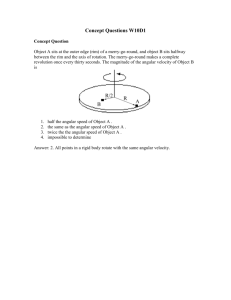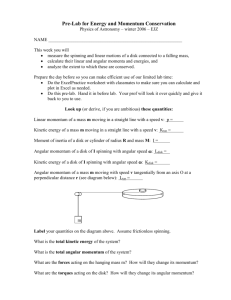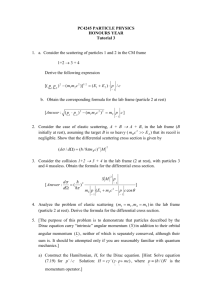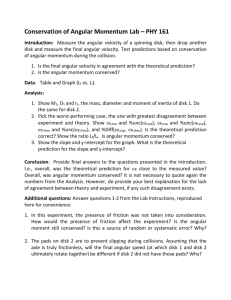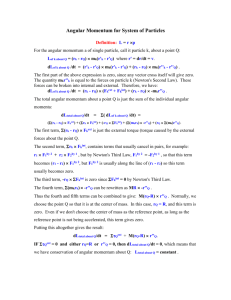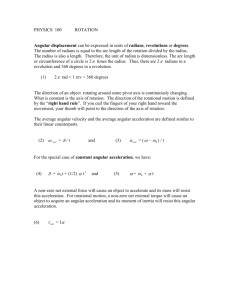General Physics 2110
advertisement
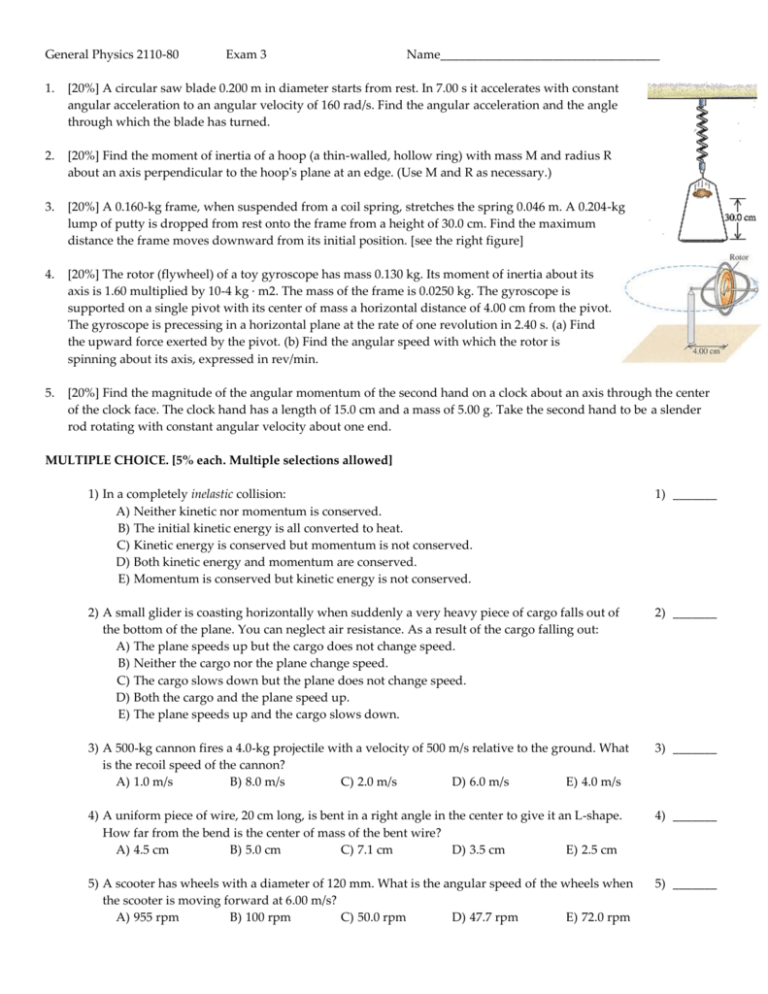
General Physics 2110-80 Exam 3 Name___________________________________ 1. [20%] A circular saw blade 0.200 m in diameter starts from rest. In 7.00 s it accelerates with constant angular acceleration to an angular velocity of 160 rad/s. Find the angular acceleration and the angle through which the blade has turned. 2. [20%] Find the moment of inertia of a hoop (a thin-walled, hollow ring) with mass M and radius R about an axis perpendicular to the hoop's plane at an edge. (Use M and R as necessary.) 3. [20%] A 0.160-kg frame, when suspended from a coil spring, stretches the spring 0.046 m. A 0.204-kg lump of putty is dropped from rest onto the frame from a height of 30.0 cm. Find the maximum distance the frame moves downward from its initial position. [see the right figure] 4. [20%] The rotor (flywheel) of a toy gyroscope has mass 0.130 kg. Its moment of inertia about its axis is 1.60 multiplied by 10-4 kg · m2. The mass of the frame is 0.0250 kg. The gyroscope is supported on a single pivot with its center of mass a horizontal distance of 4.00 cm from the pivot. The gyroscope is precessing in a horizontal plane at the rate of one revolution in 2.40 s. (a) Find the upward force exerted by the pivot. (b) Find the angular speed with which the rotor is spinning about its axis, expressed in rev/min. 5. [20%] Find the magnitude of the angular momentum of the second hand on a clock about an axis through the center of the clock face. The clock hand has a length of 15.0 cm and a mass of 5.00 g. Take the second hand to be a slender rod rotating with constant angular velocity about one end. MULTIPLE CHOICE. [5% each. Multiple selections allowed] 1) In a completely inelastic collision: A) Neither kinetic nor momentum is conserved. B) The initial kinetic energy is all converted to heat. C) Kinetic energy is conserved but momentum is not conserved. D) Both kinetic energy and momentum are conserved. E) Momentum is conserved but kinetic energy is not conserved. 1) _______ 2) A small glider is coasting horizontally when suddenly a very heavy piece of cargo falls out of the bottom of the plane. You can neglect air resistance. As a result of the cargo falling out: A) The plane speeds up but the cargo does not change speed. B) Neither the cargo nor the plane change speed. C) The cargo slows down but the plane does not change speed. D) Both the cargo and the plane speed up. E) The plane speeds up and the cargo slows down. 2) _______ 3) A 500-kg cannon fires a 4.0-kg projectile with a velocity of 500 m/s relative to the ground. What is the recoil speed of the cannon? A) 1.0 m/s B) 8.0 m/s C) 2.0 m/s D) 6.0 m/s E) 4.0 m/s 3) _______ 4) A uniform piece of wire, 20 cm long, is bent in a right angle in the center to give it an L-shape. How far from the bend is the center of mass of the bent wire? A) 4.5 cm B) 5.0 cm C) 7.1 cm D) 3.5 cm E) 2.5 cm 4) _______ 5) A scooter has wheels with a diameter of 120 mm. What is the angular speed of the wheels when the scooter is moving forward at 6.00 m/s? A) 955 rpm B) 100 rpm C) 50.0 rpm D) 47.7 rpm E) 72.0 rpm 5) _______ 6) An Atwood machine has a mass of 3.50 kg connected by a light string to a mass of 6.00 kg over a 6) _______ pulley with a moment of inertia of 0.0352 kg and a radius of 12.5 cm. If the system is released from rest, what is the speed of the masses after they have moved through 1.25 m? A) 4.95 m/s B) 4.00 m/s C) 2.28 m/s D) 2.00 m/s E) 6.00 m/s 7) The torque required to turn the crank on an ice cream maker is 4.50 Nm. How much work does it take to turn the crank through 300 full turns? A) 1350 J B) 4240 J C) 8480 J D) 2120 J E) 2700 J 7) _______ 8) A 15.0-kg child is sitting on a playground teeter-totter, 1.50 m from the pivot. What force, applied 0.300 m on the other side of the pivot, is needed to make the child lift off the ground? A) 22.5 N B) 75.0 N C) 736 N D) 66.2 N E) 44.1 N 8) _______ 9) A uniform solid sphere has a moment of inertia I about an axis tangent to its surface. The moment of inertia of this sphere about an axis through its center is: A) 2/7 I B) 1/7 I C) 3/5 I D) 2/5 I E) 7/5 I 9) _______ 10) A horizontal disk rotates about a vertical axis through its center. Point P is midway between the center and the rim of the disk, and point Q is on the rim. If the disk turns with constant angular velocity, which of the following statements about it are true? A) Q is moving twice as fast as P. B) The linear acceleration of P is twice as great as the linear acceleration of Q. C) P and Q have the same linear acceleration. D) The angular velocity of Q is twice as great as the angular velocity of P. E) None of the above. 10) ______ 11) When is the angular momentum of a system constant? A) when the linear momentum and the energy are constant B) when no torque acts on the system C) when no net external force acts on the system D) when the total kinetic energy is constant E) when the moment of inertia is constant 11) ______ 12) In an interesting lecture demonstration a student sits in a swivel chair holding a spinning bicycle wheel oriented with its axis vertical. Initially the chair is motionless. Now the student rotates the axis of the spinning wheel by 180°, so that it is again vertical, but now the wheel is spinning in the opposite sense with respect to the room. When this is done the student and chair begin to rotate also. Which of the following is an accurate statement concerning this process? A) Angular momentum, but not angular kinetic energy, is conserved in this process, independent of whether or not friction is present. B) In the final state the chair will be rotating in the opposite sense of the wheel, but at a much higher frequency. C) Angular velocity is conserved in this process. D) In the final state the chair will be rotating in the same sense as the wheel, but at a much lower frequency. E) Assuming the swivel bearing of the chair is frictionless, angular kinetic energy is conserved in this process. 12) ______ 1) E 2) B 3) E 4) D 5) A 6) C 7) C 8) C 9) A 10) A 11) B 12) A


